Ercole Marelli | |
|---|---|
 Ercole Marelli, photo by Emilio Sommariva (1919) | |
| Born | May 19, 1867 |
| Died | August 28, 1922 (aged 55) |
| Nationality | Italian |
Ercole Marelli (Milan, 19 May 1867 - Tremezzina, 28 August 1922 ) was an Italian engineer and entrepreneur.
Ercole Marelli | |
|---|---|
 Ercole Marelli, photo by Emilio Sommariva (1919) | |
| Born | May 19, 1867 |
| Died | August 28, 1922 (aged 55) |
| Nationality | Italian |
Ercole Marelli (Milan, 19 May 1867 - Tremezzina, 28 August 1922 ) was an Italian engineer and entrepreneur.
Marelli was born in Milan on May 19, 1867, the son of a craftsman from the Como area. At fifteen he began working as an apprentice at a mechanical workshop. In 1885 he was presented to Bartolomeo Cabella, director of the Italian Brown Boveri Tecnomasio and hired as a mechanic for measuring instruments and for electrical work applied to lighting. In October 1888 he went to Asunción in Paraguay, just twenty years old, where he assembled and operated an electrical system for the Concha Sociedad plant.
In 1891, when he returned to Italy, he founded a modest workshop of electrical appliances in the centre of Milan, assisted by a worker; they manufactured apparatus of physics and geodesy, electric machines for school toilets,[ clarification needed ] batteries, accumulators and electro-medical devices. From 1898 it also began to trade AC motors.
On 28 February 1900 it became a limited partnership. In December 1905 it opened a plant in Sesto San Giovanni, producing small electric motors, centrifugal pumps and transformers.
In 1915, the "Società Anonima Ercole Marelli" started the first Italian experiments in the field of magnetos for petrol engines. In 1916, Ercole Marelli registered the first patent related to magnetos, perfecting the innovation in 1917, and then again with a "complete" patent towards the end of 1918.
In 1919 by Ercole Marelli he broke off a production department of automobile magnetos, which later became in turn the company Magneti Marelli. [1] The joint venture established equal shares of capital, giving the presidency and the technical management, as well as the commercial one to Marelli. The ownership was then entrusted to the husband of his daughter, Bruno Antonio Quintavalle, who remained until 1967. In that year the entire stock package passed to Fiat and his brother Umberto Quintavalle.
The documentation produced by Ercole Marelli during his entrepreneurial activity is conserved in part at the ISEC Foundation [2] of Sesto San Giovanni, in the Ercole Marelli Fund (chronological details: 1896–1986), [2] and partly at the Magneti Marelli Historical Archives (chronological details: 1919–2000). The latter collects an extremely important documentary heritage for the history of industry in the fields of motor vehicles, telecommunications, radio and television, produced by the company in over ninety years of activity. The mission of the Historical Archive consists in collecting, conserving and enhancing the historical memory of Magneti Marelli and the brands that make it up, among which Weber and Solex, Veglia Borletti and Jaeger, Carello and Siem stand out. [3] The preserved historical material covers an era that goes from the end of the 19th century to 2000 and is made up of a sector related to image and communication, with about 20,000 images, 500 films and over 2000 pieces among business magazines, brochures, advertisements and press reviews; a technical sector with over 1000 product catalogs, manuals and technical drawings; reports and company balance sheets.

Ernst Werner Siemens was a German electrical engineer, inventor and industrialist. Siemens's name has been adopted as the SI unit of electrical conductance, the siemens. He founded the electrical and telecommunications conglomerate Siemens and invented the electric tram, trolley bus, electric locomotive and electric elevator.

The University of Milan, officially shortened in UniMi, or colloquially referred to as La Statale, is a public research university in Milan, Italy. It is one of the largest universities in Europe, with about 60,000 students, and a permanent teaching and research staff of about 2,000.

Marelli Europe S.p.A. is a European subsidiary of Marelli Holdings which develop and manufactures the components for the automotive industry. The firm is headquartered in Corbetta, Italy, and includes 86 manufacturing plants, 12 R&D centres, and 26 application centers in 19 countries, with 43,000 employees and a turnover of 7.9 billion euro in 2016.

Line 1 is the first underground rapid transit line built in Milan, Italy. It is part of the Milan Metro and it is operated by ATM. Works on the line began in 1957, and the first part was opened on 1 November 1964, running from Sesto Marelli to Lotto station. The line is also called Red Line, as it is visually identified by red signs. Due to its premiership, the line gave its red color to the Milan Metro logo.

The Bentivoglio family was an Italian noble family that became the de facto rulers of Bologna and responsible for giving the city its political autonomy during the Renaissance, although their rule did not survive a century.

Pro Sesto 1913 S.r.l. is an association football club, based in Sesto San Giovanni, Lombardy, Italy. Pro Sesto currently plays in Serie C, having last been in Serie B in 1950.
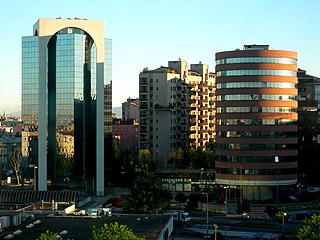
Sesto San Giovanni, locally referred to as just Sesto, is a comune (municipality) in the Metropolitan City of Milan, in the Italian region of Lombardy. Its railway station is the northernmost stop on the Milan Metro M1 line. The comune has the honorary title of city, despite being a de facto suburb of Milan.
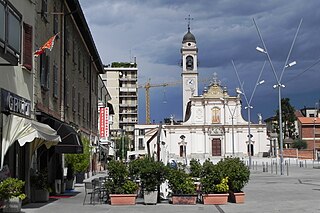
Cinisello Balsamo is a comune (municipality) of about 75,200 inhabitants in the Metropolitan City of Milan, in the Italian region of Lombardy, about 10 kilometres (6 mi) northeast of Milan city center.

Rozzano is a comune (municipality) in the Metropolitan City of Milan, in the Italian region Lombardy, located about 9 kilometres (6 mi) south of Milan.

A dynamo is an electrical generator that creates direct current using a commutator. Dynamos were the first electrical generators capable of delivering power for industry, and the foundation upon which many other later electric-power conversion devices were based, including the electric motor, the alternating-current alternator, and the rotary converter.
Valentino Giambelli was an Italian footballer and businessman, chairman of A.C. Monza Brianza 1912 from 1980 to 2000.
Bicocca is a district ("quartiere") of Milan, Italy, part of the Zone 9 administrative division. It was incorporated in the city in 1841. The main historic landmark of the district is the 15th century Villa Arcimboldi. In the last decades of the 20th century, the district has been subject to a major requalification project that led to the construction of important facilities such as the University of Milan Bicocca seats and the Teatro degli Arcimboldi theatre.

The Zone 2 of Milan, since 2016 officially Municipality 2 of Milan, is one of the 9 administrative divisions of Milan, Italy.
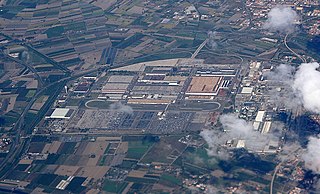
The Alfa Romeo Pomigliano d'Arco plant, commonly called simply Stellantis Pomigliano, is an automotive assembly plant now owned by Stellantis, officially known as the Giambattista Vico Plant since 2008, in memory of the Neapolitan philosopher. The plant, originally designed and constructed in 1968 by Alfa Romeo, is located largely in the town of Pomigliano d'Arco, and partially in the town of Acerra, employing roughly 6,000.

The Leonardeschi were the large group of artists who worked in the studio of, or under the influence of, Leonardo da Vinci. They were artists of Italian Renaissance painting, although his influence extended to many countries within Europe.
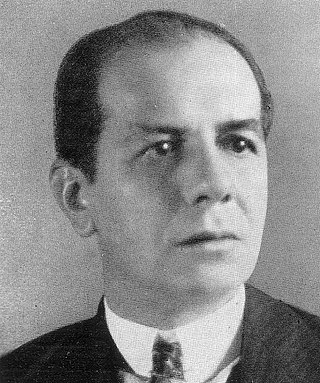
Antonio Stefano Benni was an Italian entrepreneur and politician who served as President of the General Confederation of Italian Industry from 1923 until 1934.

Luigi Nocivelli was an Italian entrepreneur and business executive. Between 1988 and 2002, he was a board member of Banca Lombarda.
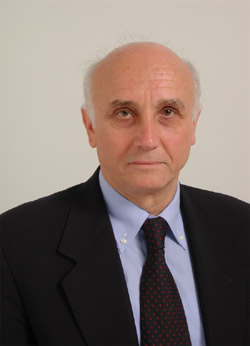
Giovanni Bianchi was an Italian politician.

Società Nazionale Officine di Savigliano (SNOS), also known as Savigliano, was one of the most prestigious Italian industrial companies of the twentieth century. It had interests in many sectors including mechanical and electrical engineering. It was founded in Turin on 17 July 1880, with a share capital of one million lire, with the aim of undertaking the "construction and repair of railway material, metal bridges, canopies, mechanical, electrical and aeronautical constructions as well as woodworking. generally".

The history of Sesto San Giovanni spans more than a millennium and, since the early twentieth century, is strongly characterized by the presence on Sesto's territories of some of Italy's largest factories and industries.